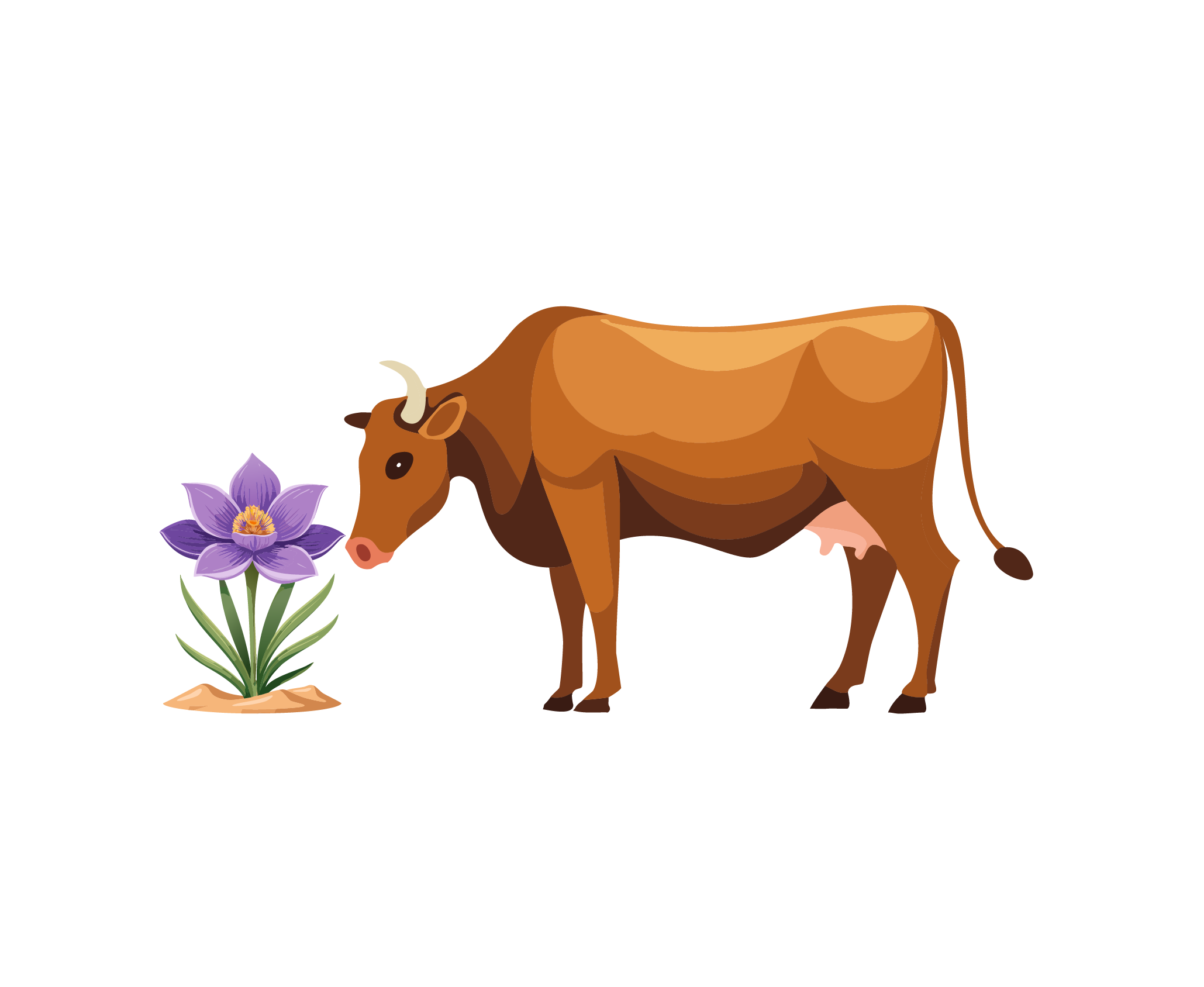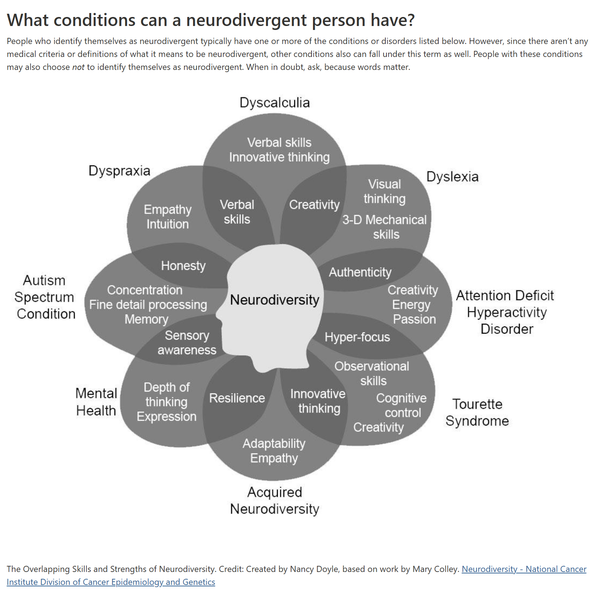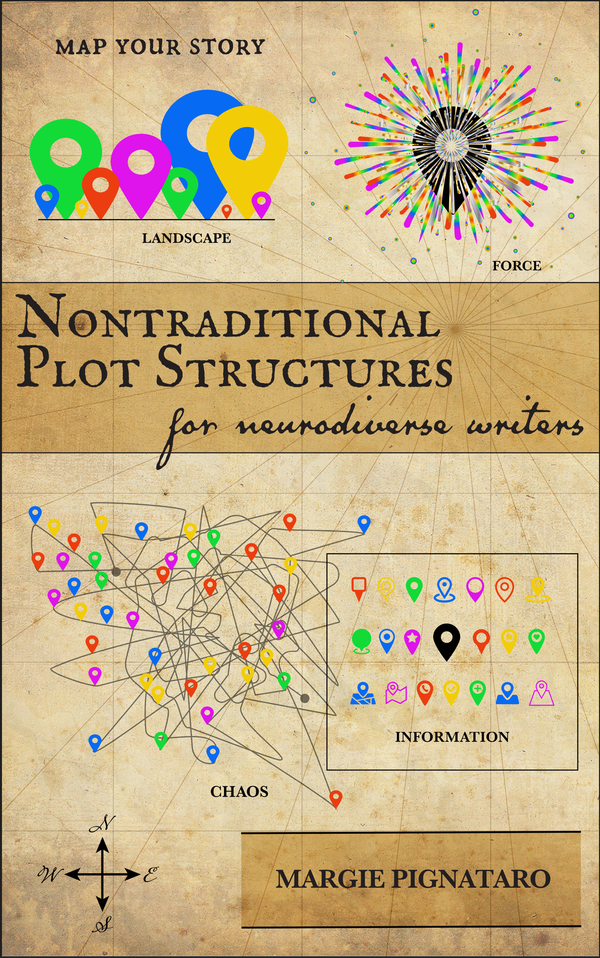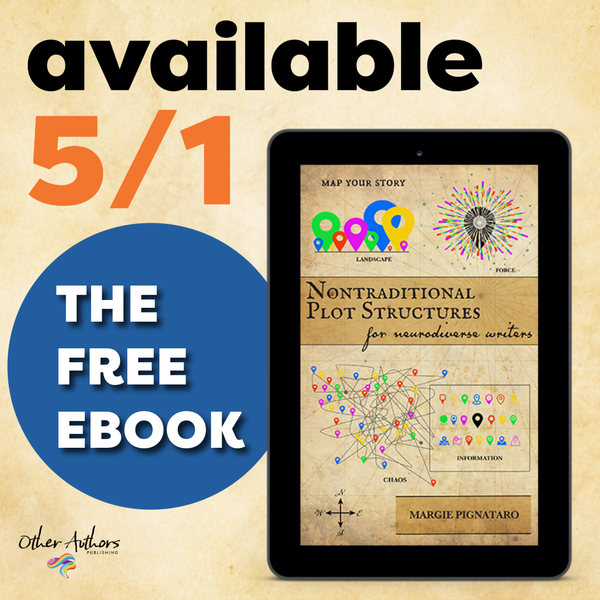INFORMATION: Another Story Structure for Neurodiverse Writers
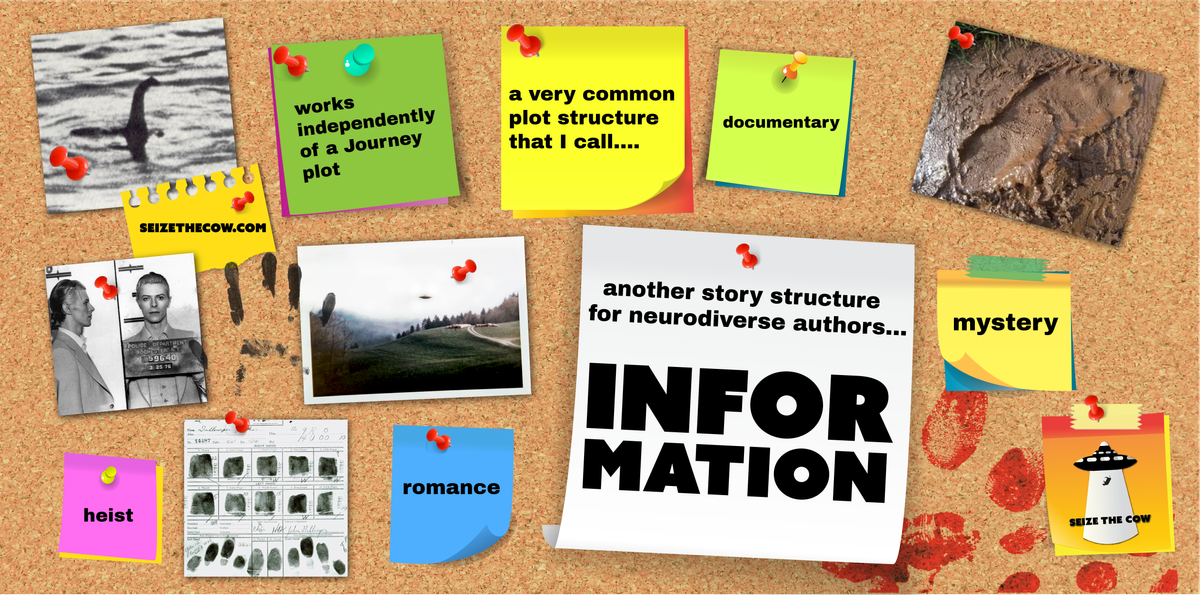
I've been thinking about plot structure for over ten years. I couldn't understand why I could explain a conventional journey structure, but struggled to construct one.
Then in the middle of a doctoral theater theory course, my professor asked, "Does a traditional plot structure reflect your experiences of the world?"
No, absolutely not. I don't think it reflects anyone's. I don't believe in clean endings. I don't think all events have meaning and that the world has order. I don't think everyone needs a goal, nor that all goals can be or should be achieved. I don't believe that time is a linear experience. I don't believe in "main characters". I don't believe life is structured in conflict.
So after reading quite a lot more and reading heaps of theory and plays and books and watching movies, I have a clearer picture of what I'm talking about. Then I was diagnosed with ADHD and autism, and I have an even clearer picture of what I'm talking about.

In order to maintain clarity, I'll take this piece by piece. A traditional plot structure I will refer to as a Journey structure. A main character has a goal to achieve and the events of the story are about reaching that goal. There are obstacles, a climax, and an ending. Almost every mainstream book, TV show, and movie follow this structure. It is so common, no one questions it. It is seen as the "right" way to construct a story.
In previous posts on Instagram and this blog, I've discussed Chaos structure at length. The thread of a Chaos structure isn't easily discerned, but all events that occur within that structure are related, even if it isn't clear. It can seem like nonsense or even gibberish, but there's always a connection. A timeline can loop or invert. An audience may have no idea what's happening. The result is more of an emotional one rather than logical. This is based on the scientific definition of Chaos.
I've also argued that the Chaos structure is more comfortable and natural for neurodiverse writers. I say this because I've written plays using this structure and have had success with audiences and, personally, found them satisfying. (I am particularly interested in other writers experimenting with this structure. If you'd like to, please send me what you have to email to discuss this further.)
Chaos works well with ADHD thinking patterns because it is random, not bogged down in a detail structure, includes only material that the writer finds "interesting", and can be written in short bursts, which works better with lower attention spans. Chaos also fits rapid thinking, leaping from one subject to the next with seemingly little connection (yet always present).
People with ADHD jump about in conversations because they're making fast connections and rejecting conventional conversation structure. This is what Chaos does with a story. People with autism would rather have structure and organization, and perhaps Chaos doesn't work for them. But Chaos can be a massive stim.
Rather than seeing a story as one long, unending event, Chaos treats events like objects that can be organized in any way the writer prefers. Events can be examined in detail, repeated, described differently each time. There is still a structural connection; there is still a thread holding everything together. Chaos is a box full of action figures, and all of the figures have one thing in common that binds them together (eg. they're all superheroes, or 19th century literary figures or both and more).
Another structure I've found which I find particularly delicious is the Information structure. I say "delicious" deliberately because the act of acquiring information and organizing it is extremely stimulating.
Human beings are obsessed with information and there's quite a lot of information out there about our lust for it. It's emerges from our survival instincts: the more information we have, the safer we are.
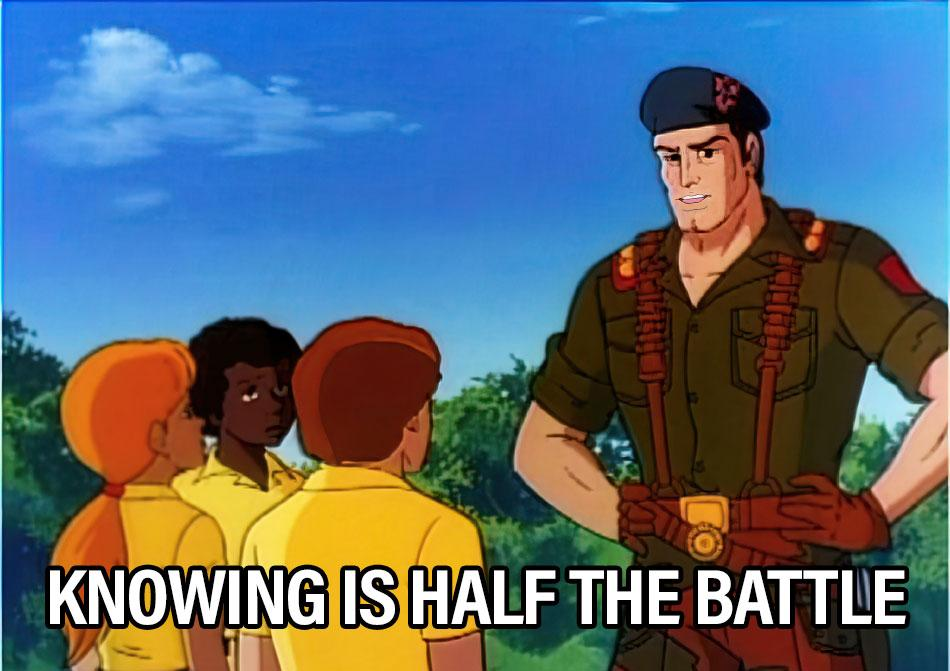
Information
Chloe Tucker has written a very clean definition of information creation:
"...well-formed and meaningful data + meaning = information.
Data can be discovered, generated, or observed. But because meaning requires interpretation of the data, information is created. The data is discovered, meaning is assigned to the data, and information is born."
Information Creation
Information isn't something that exists independently in the world. Information occurs when the data (a collection of facts) is organized into a kind of story.
The ultimate goal of an Information plot structure is discovering data and constructing information. This takes the form of characters often discovering data or presenting data to the audience.
Anything with an Information structure begins with a mystery, thesis, or puzzle. Characters can be seeking to reveal a mystery, put information in the right sequence to solve a puzzle, or prove a thesis.
There are several types of Information plot structures. These may not seem like "stories", but they do qualify.


Heist
A Heist story focuses on individuals attempting to take by force an object. To do so requires planning, enormous amounts of information, and, of course, force. This is built around a thesis: We will accomplish this because we're the best at what we do and we're smarter and more powerful. Heist films are enormously popular. I would categorize Indiana Jones films as Heist plots, considering the amount of research and information is required to accomplish his goal. All of the Uncharted games are heists. Most video games could be considered Heist plots, but that's another blog post.

Romance
This is probably the weirdest discovery of an Information plot I've had. At first, I thought I was nuts to consider this, but then I remembered conversations I had in college with my best friend. She was obsessed with an actor in our theater department. We would spend hours happily analyzing all of his actions, seeking evidence of interest in her. We'd construct scenarios to "run into him" or go to parties we suspected he'd attend.
Romance is all about information. It doesn't need to be as intense as my conversations with my friend, but both individuals in a romance are trying to discover the other person. They collect information about their viability and trustworthiness. It's a puzzle both characters are trying to solve. Sometimes they misunderstand the evidence or are given false information. The dramatic irony about the story is that the audience already knows how to solve the puzzle. We wait for the characters to discover it on their own.

Documentary
This is the purest, rawest form of an Information structure and one that is almost entirely relegated to non-fiction subjects. Documentaries can have any focus, but usually they're driven by a thesis: "Jack the Ripper was a frightening, violent, horrifying element of Victorian English society that has influenced our views of crime today." It doesn't have to be anything elaborate and most aren't.
It is entirely viable and artistically sound for any fiction story to have an Information structure in the form of a documentary, regardless of format. It would present characters and events from a completely clinical and fresh perspective.

Instruction
I understand this is a wacko one to include and it seemingly has nothing to do with fiction writing, but indulge me.
An Instruction structure we see all the time on the internet. There are billions of videos on YouTube giving instructions about anything you can think about. Watching these videos are entertaining and they definitely tell a story.
The instructions are organized information. Sometimes the instructions aren't specified and we watch people construct a coffee table through the process. It's a thesis format: If you do this, then this will happen.
This can work with fiction. Let's use Jack the Ripper again.
Events are presented which reveal all the ingredients necessary for Jack the Ripper to be able to kill. Then his killing would be a presentation of all the ingredients being used. This kind of structure would necessitate Jack being the sole focus as the "teacher" and lack any details about the lives of others or the police investigations. This format would also fit the profile of a psychotic, narcissistic serial killer: Jack, of course, would see his history as being only about him and his actions ONLY a series of events designed to fulfill his desires.
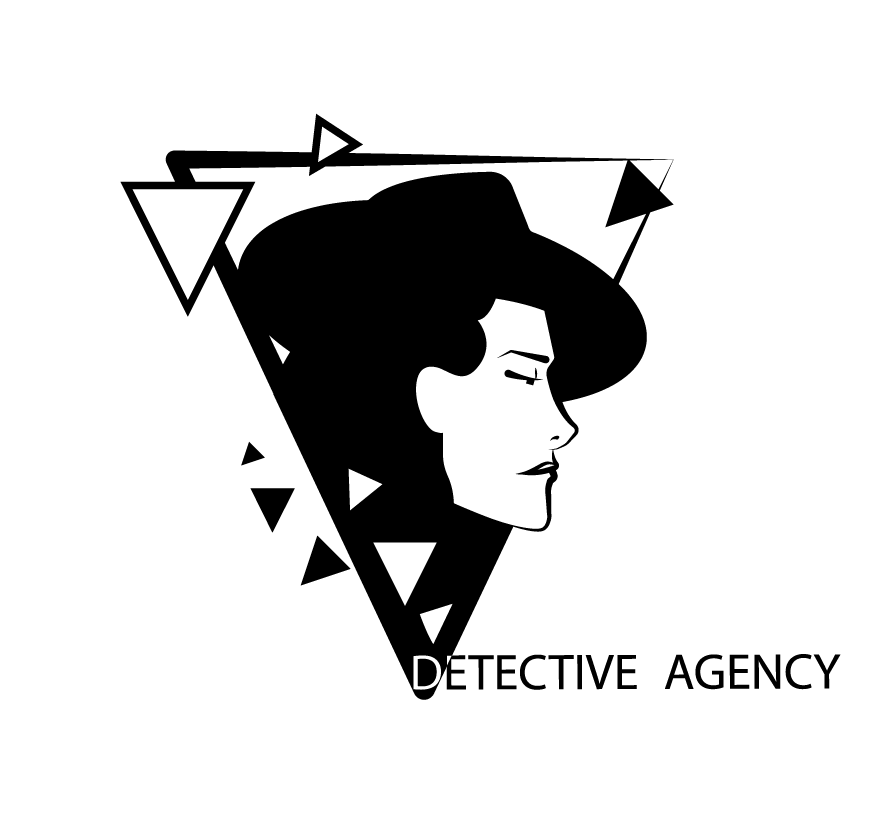
Mysteries
I've saved the most popular and most loved for last. Murder mysteries are not the only kind of mystery that qualifies, but it is, by far, the most read and coveted.
I have quite a lot to say about murder mysteries as a whole and Information structure, but I'll save that for another blog. I plan to take the nursery rhyme "Jack and Jill" and mold it to the different Information formats.
This is a list of general characteristics of murder mysteries that involve Information:
- The goal of every murder mystery is to find the murderer. This is accomplished through information gathering.
- Characters become mouthpieces of information and audiences don't care if they're used as devices.
- The information is what is important, arranging it and discarding bits in order to solve the puzzle and find the killer.
- An information structure focuses on:
- gathering data (clues)
- building information (what happened)
- forming a conclusion (identity of the killer)
- The physical presence of information is a major component of the story:
- detectives assemble boards mapping out information
- the police have files and photos (particularly the crime scene)
- the corpse is a massive reposition of valuable information (often coroners will talk about how corpses tell a story)
- The main character tasked to solve the mystery.
- Collecting information can be dangerous, life-threatening, wrecking havoc on the investigator's personal life.
- Collecting information is of supreme importance and necessary for survival and the self.
- A mystery is a Journey structure in reverse. When the story begins, the journey has already concluded. The journey is the murderer killing their target. The Information structure takes those past events and analyzes them from an outside perspective in order to come to a conclusion.
Neurodiverse Writers and Information
An Information Plot Structure is nothing more than artistic info dumping.
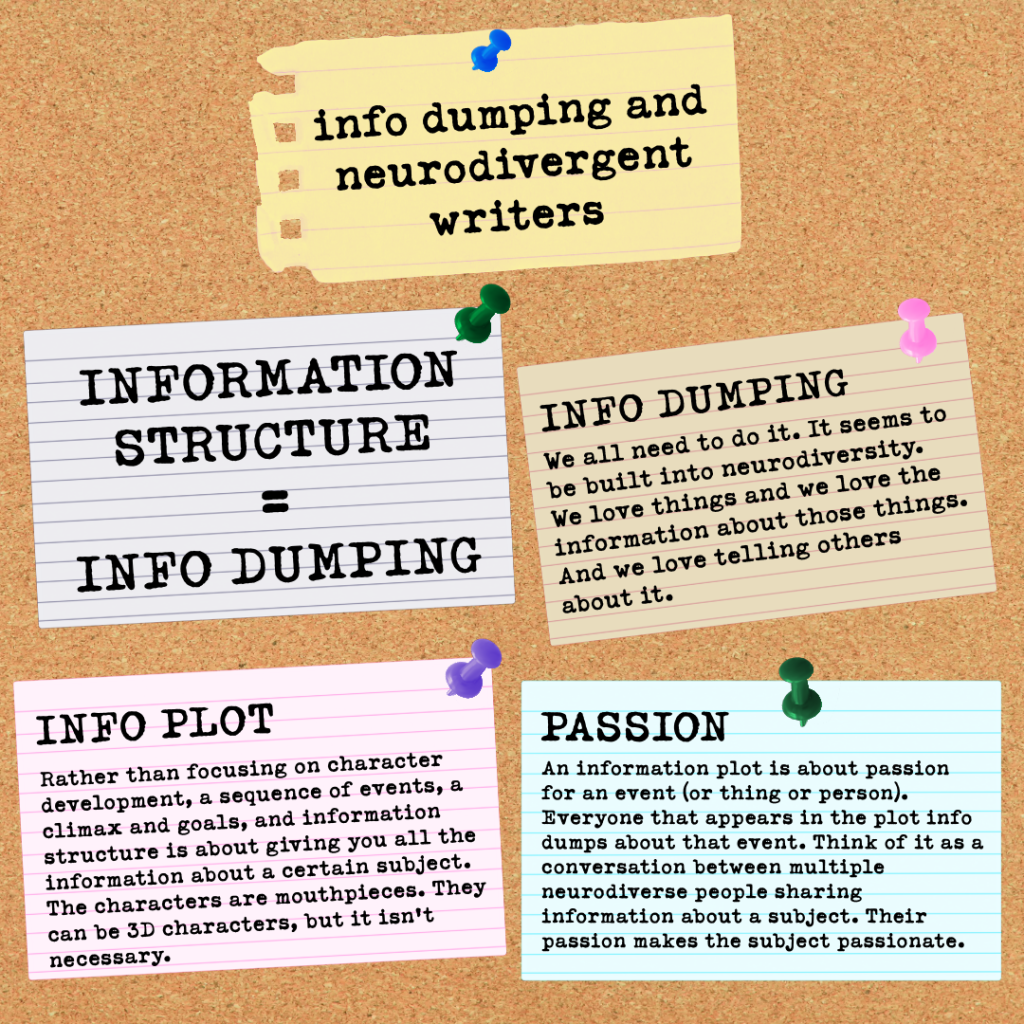
I've written about three plot structures: Journey, Chaos, and Information.
I've been speaking of these structures in absolute terms: I've been implying that a story can have ONLY ONE structure. A Journey story is ONLY a Journey story, and so on.
This isn't true. In fact, stories can have more than one structure and often do. This is what creates such a varied and vibrant treasure trove of fiction and opens up many creative possibilities for writers. Most especially, different forms of writing that are much more comfortable for neurodivergent writers.
I also want to stipulate that I think Journey structures are not inferior to any other. I think that Journey structures are a very easy means for helping an audience through a story. But it doesn't have to be only a Journey structure.
Murder mysteries are constructed with both Journey and Information.
Chaos stories can easily intertwine with Information, as well as Journey.
Furthermore, there are even more structures.
As always, thank you for reading. If you have any questions or comments, please contact me. If you're interested in coaching, I have merciful, empathetic rates.
